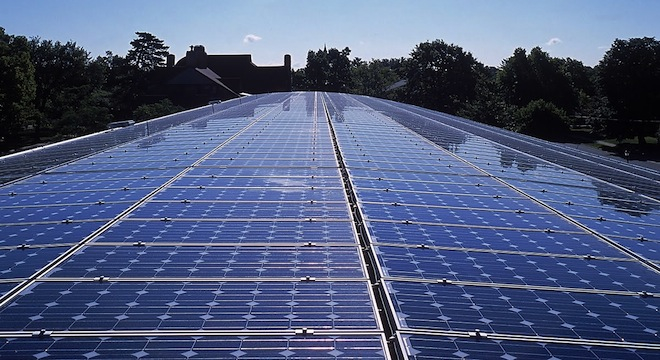TINA CASEY
When you go about designing the world’s most efficient solar cell, the natural inclination is to develop a device that can trap as much light as possible.
Yet, in a counter-intuitive leap, scientists at Lawrence Berkeley National Laboratory in California have smashed the previous world record by designing a solar cell that emits more light.
The light is fluorescent, so it is not visible under normal conditions, but it still consists of photons and that’s what counts.
The calculated release of photons enabled the research team to find a way around a key factor that limits the efficiency of a single junction solar cell: if too much light is absorbed, the solar cell loses excess energy in the form of heat instead of converting it to electricity (single junction basically refers the use of a single material to collect light in a solar cell, rather than a “sandwich” of multiple materials).
Theoretically, the most efficient single junction solar cell could convert about 33.5 percent of the solar energy it collects into electricity.
So far, the closest that scientists have gotten to that limit is about 24 percent. The Berkeley team’s new fluorescent solar cell leapfrogs over that bar with an efficiency of 28.4 percent.
The ability of the fluorescent effect to “boost” the voltage of a solar cell was predicted by a member of the research team, Owen Miller, who calculated that a rare material called gallium arsenide would release enough photons to achieve a more precise balance between the amount of light absorbed and the amount converted to electricity.
Gallium arsenide is made from arsenic and gallium, which is a byproduct of aluminum smelting. This nasty-sounding compound turns out to be an ideal material for solar cells, partly due to its ability to withstand high temperatures.
The hitch is that gallium arsenide is far more expensive than silicon, the most common material used in solar cells. In order to survive in the commercial market, a gallium arsenide solar cell would have to be far more efficient than its silicon-based competitors.
The Berkeley solar cell has a good chance of achieving that benchmark, since a relatively small amount of gallium arsenide can do the same job that a much larger chunk of silicon can do. A highly efficient gallium arsenide solar cell can be just a few microns thick. In comparison, crystalline silicon requires a thickness of at least 100 microns.
In a statement for the press, lead researcher Eli Yablonovitch explained, “Gallium arsenide absorbs photons 10,000 times more strongly than silicon for a given thickness but is not 10,000 times more expensive. Based on performance, it is the ideal material for making solar cells.”
There are other ways to get around the cost factor, such as layering gallium arsenide onto a cheaper substrate, growing new gallium arsenide cells on a reusable template, or developing manufacturing processes that create an extremely thin film.
As for whether or not you can get a gallium arsenide solar cell on your roof any time soon, Yablonovitch has co-founded a company called Alta Devices, which will deploy a thin film process (also developed by Yablonovitch) to churn out solar cells at a relatively low cost. They will hit the market within a year, so go ahead – hold your breath.









